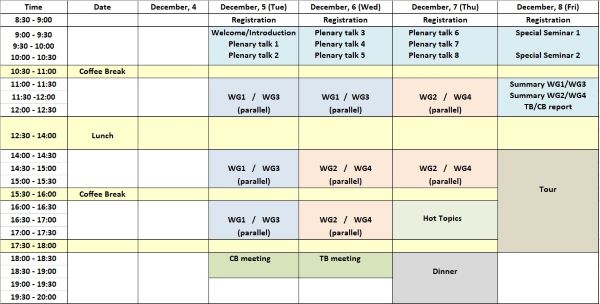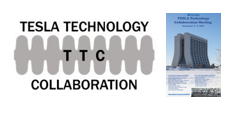
In addition to Plenary Sessions, the meeting will have Parallel WG Sessions. If you would like to contribute a WG presentation, please contact WG conveners.
-
WG-1: Progress on High Q and High Gradient activities
Conveners: Jinfang Chen (SARI), Daniel Bafia (FNAL), Akira Miziyaki (IJCLab), Detlef Reschke (DESY)
The scope of this working group is to discuss the most recent results related to pushing niobium towards higher Q and higher gradient. Advances in understanding material evolution under established but also newly developed heat treatments, such as N-doping, N-infusion, Mid-T bake, Two-step Low-T bake with low-temperature EP, and current results on flux-expulsion studies should be discussed. The working group should also focus on operational experiences in existing high-Q/high-G cryomodules. Topics should discuss the activities on large and medium grain niobium materials including results from cavity fabrication, cavity performances and PED requirements. Results from cavity studies with different cavity types and frequencies, which could help to establish a core understanding, should be included.
-
WG-2: Developments and experiences with emerging TEM- and TE-mode cavities: Spoke resonators and Crab cavities
Conveners: Jun Tamura (JAEA), Suba De Silva (ODU), David Longuevergne (IJCLab)
Several SRF projects related to TEM-mode cavities like Spoke resonators and TE-mode cavities like Crab cavities are in the commissioning or early operation stage. The scope of this working group is to present and discuss lessons learned during hardware testing, beam commissioning and during operation. Topics should include experiences with both cavities and cryomodules as well as with the cavity ancillaries (couplers, tuners, RF controls and cryogenic systems). Technical issues would include multipacting, field emission, quenches, frequency control and associated mitigations for each.
-
WG-3: Novel clean assembly techniques, in-situ mitigation, and recovery processes
Conveners: Naruhiko Sakamoto (RIKEN), Martina Martinello (SLAC), Enrico Cenni (CEA)
Research and development to improve clean assembly and installation techniques inside and outside the cleanroom for suppressing field emission is being carried out in many worldwide laboratories. The scope of this working group is to present and discuss novel clean assembly techniques including robotics and semi-automated procedures to prevent dust particle contaminations and migrations. Topics can also include methods to carefully install “clean” cryomodules into existing “dirty” facilities or techniques to reduce particulate migration to maintain on-line performance. Topics should also include in situ cleaning techniques like pulsed RF conditioning, plasma processing and helium processing and off-line techniques like high pressure rinsing to mitigate field emission in various types of cavities and cryomodules.
-
WG-4: Design, experience, and operation with high-beta/beta=1 cryomodules and sub-components
Conveners: Han Li (IASF), Serena Barbanotti (DESY), Dan Gonnella (SLAC)
The WG-4 scope is to present and discuss the design and experience gained in operating existing high-beta and beta=1 cryomodules. Topics should include considerations to reduce static losses, to lower residual magnetic fields and design/assembly procedures for achieving precise alignment in cryomodule operation. Topics should also include the preparation/design of sub-components like input couplers, HOM couplers/dampers, tuners, magnetic shielding, and SC magnets, as well as the impact of fast or slow cooldown procedures on cavity performance. Also of interest are experiences in low pressure operation as a means to circumvent PED regulation requirements. Safety instrumentation for a reliable cryomodule operation should also be presented.
-
Hot topic discussion: Challenges for conduction-cooled SRF cavity technology
Conveners: Akira Yamamoto (KEK), Gianluigi Ciovati (JLab), Jens Knobloch (HZB/Universität Siegen)
Hot topic discussion will focus on the technical challenges of SRF accelerators based on conduction cooling. The discussion will address the current "state-of-the-art" for conduction-cooled SRF cavity technology and the technical challenges associated with the choice of cryocoolers, thermal link designs, Nb3Sn thin film performance, and tunability of Nb3Sn coated cavities.
-
Special Seminar 1: The science of FRIB: From the nuclear many-body challenge to the origin of the elements in the Universe
Speaker: Prof. Alexandra Gade (MSU)
There are approximately 300 stable and 3,000 known unstable (rare) isotopes. Estimates are that over 7,000 different isotopes are bound by the nuclear force. It is now recognized that the properties of many yet undiscovered rare isotopes hold the key to understanding how to develop a comprehensive and predictive model of atomic nuclei, to accurately model a variety of astrophysical environments, and to understand the origin and history of elements in the Universe. Some of these isotopes also offer the possibility to study nature's underlying fundamental symmetries and to explore new societal applications of rare isotopes. This presentation will give a glimpse of the opportunities that arise at the Facility for Rare Isotope Beams (FRIB) that started operations at Michigan State University in 2022.
-
Special Seminar 2: SRF technology for Quantum Computing and Dark Matter Searches
Speaker: Dr. David Van Zanten (Fermilab)
Quantum information science is no longer a field of uniquely theoretical endeavors. Current state-of-the-art quantum hardware is capable of processing shallow algorithms and nearly reaches the domain where classical computing will struggle. In addition to the increase in performance, the last decade has shown a broadening of applications well beyond the typical mantra of the programmable quantum processor. A telling example is the use of quantum states for the detection of particles and Dark Matter searches. Despite the advancements of the last decade, there is still ample room for new experiments and a pressing need for improvements. Adopting elements from Superconducting Radiofrequency technologies will help to push the frontier of this field. In this talk I will introduce the concepts of Quantum Information science and discuss why the field would benefit from SRF technologies and how the combination of SRF technologies and Quantum Information science leads to new enabling technologies for example for Dark Matter searches.
